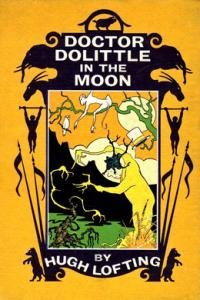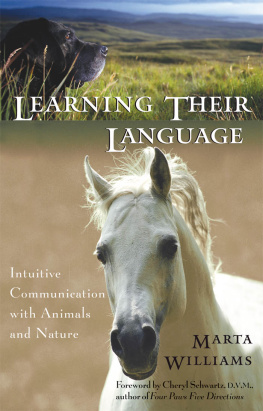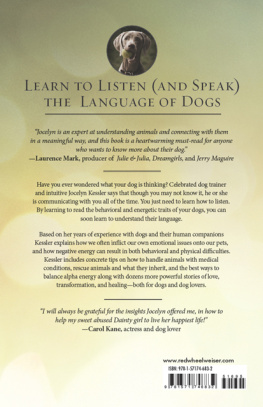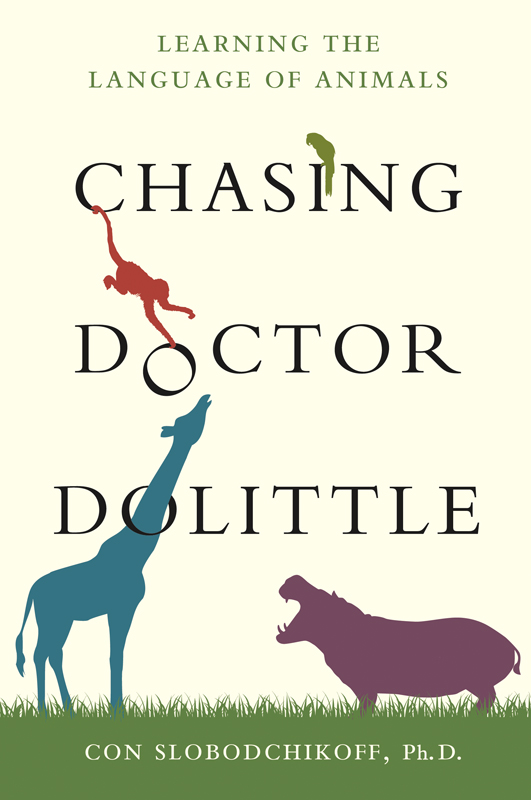
The author and publisher have provided this e-book to you for your personal use only. You may not make this e-book publicly available in any way. Copyright infringement is against the law. If you believe the copy of this e-book you are reading infringes on the authors copyright, please notify the publisher at: u.s.macmillanusa.com/piracy.
CONTENTS

AUTHORS NOTE

Animal language is a controversial topic, and many scientists and animal behaviorists believe that animals are not capable of having language. In this book, I present evidence for what I consider to be animal language, assembled from my own (and a number of other) scientific studies. I need to point out that these are my own interpretations, and not necessarily those of the authors of the studies that I discuss. In a number of cases, the authors would probably disagree with my interpretation of their work, and by discussing their studies, I do not intend to imply that they either agree with or endorse my interpretation and my point of view. If you are interested in reading the original studies and drawing your own conclusions, I have arranged a chapter-by-chapter bibliography at the end of this book.
DOCTOR DOLITTLE AND ANIMAL LANGUAGE

Do animals have language? When they make sounds, are they really speaking? Can you imagine how the world would change if we found out that they really do have something to say? People have long been fascinated with the idea that animals can talk. I have been interested in this idea for a long time, which has prompted me to spend many years decoding the language of prairie dogs through experiments in the field and the laboratory. As far back as 2,500 years ago, Aesops fables featured animals talking to one another. Even today, we might watch two dogs barking and think that they might be talking about how strong and fierce they are, or they might be telling each other about the humans they have to live with. We have longed to know if there is any meaning behind the barks, meows, whistles, raised feathers, chemical sprays, and all the other elements that are grouped by scientists into the general category of animal communication. When our cat looks up at us and meows, wouldnt it be wonderful to know what the cat means? And when we tell our darkest secrets to our dog, wouldnt it be wonderful to know that our dog really understands us like no human friend could? This is the Doctor Dolittle fantasythat we can learn to decode animal signals and find that underneath, there is language we can understand.
In the books by Hugh Lofting, Doctor Dolittle learned to interpret the whistles, grunts, groans, and body postures of different animal species from his parrot, Polynesia, who in her long life of more than 160 years had learned all animal languages. She dictated to Doctor Dolittle a complete dictionary of all of the words that animals use, telling him that each species of animal has its own language, but all of the animals can understand one anothers languages. With that dictionary, Doctor Dolittle was able to speak to his dog, to a pig, to white mice, to monkeys, and to a variety of other animals, leading him on to many adventures around the world.
In this book, I invite you to be Doctor Dolittle. Dare to imagine that animals say meaningful things to one another. Let me play the role of Polynesia while I show you the many signals that animals use to increase their success at locating food, telling friend from foe, escaping danger, and finding a mate. After reading this book, you might not be able to set up a practice like Doctor Dolittles, but you will have a much better idea of what animals may really be saying to one another.
Let me begin by explaining that my using the term animal language is equivalent to waving a red cape in front of a bull for many scientists and academics: Its very controversial. Thats because, according to many scientists and linguistic professionals, language is the last gulf that separates us from all of the other animals. Over time, all of the other barriers have fallen by the wayside. Not too long ago, people thought that we were the only tool users, the only ones with culture, the only ones with a sense of self. All of that has crumbled as we have found out more and more about other animals. We cant even claim that we are the only ones with warfare who indiscriminately kill one another, because ants have been doing that for millions of years before us. So all we have left to cling tothat makes us special and separate, that sets us apart from all of the rest of the natural worldis language.
In my view, that separateness does not exist. We are all part of the natural world. We are the product of the same evolutionary process that has shaped every species on earth. I believe that animals might have languages that are designed to fit their needs, just has we humans have languages that are designed to fit ours. We simply dont know enough about the lives of animals to make the sweeping assumption that language is outside their capabilities. To study animal communication systems most effectively, we need to be able to understand the world from the animals point of view, and the context may not yet be apparent to us because it might be too subtle for us to recognize with our current limited sense of understanding.
The idea that animals have language is frightening to some people, but it is also empowering to animals. When people find out that an animal species has a language, they often look at that species in a more compassionate way. The prairie dogs that I have studied for many years are considered by many people to be pests and vermin, suitable only for eradication, despite the fact that they are a keystone species in grassland ecosystems, who prop up some two hundred other vertebrate species that depend to a greater or lesser extent on the activities of these animals. In just one hundred years, human activities and a disease introduced by humans have caused prairie dogs to decline to about 2 percent of their previous numbers. Many people would like to see that 2 percent decline to 0, despite the fact that it would rip to shreds the ecological functioning of grasslands.
But when I tell people that prairie dogs have a sophisticated language, opinions change. I have given a number of presentations to city councils and citizen groups about both the ecological value and the language of prairie dogs, and what really causes them to rethink their attitudes about these animals is the language aspect. Its as if they suddenly start to empathize with this creature, not as some kind of mindless pest that is bent on destroying agricultural crops and grass intended for cattle, but as a living, breathing partner in the natural world that surrounds us. And with that realization, people are far more willing to extend the opportunity to prairie dogs to coexist with humans. Instead of poisoning or shooting the animals, they suddenly become receptive to other alternatives, such as relocating them to places where they are not interfering with human activities.
Changing our attitudes in order to rebuild the bridge linking our species with other species is a risky business because of its enormous implications on our own attitudes and behaviors. We might have to start looking at animals in a different light, but it is possible to do so.











